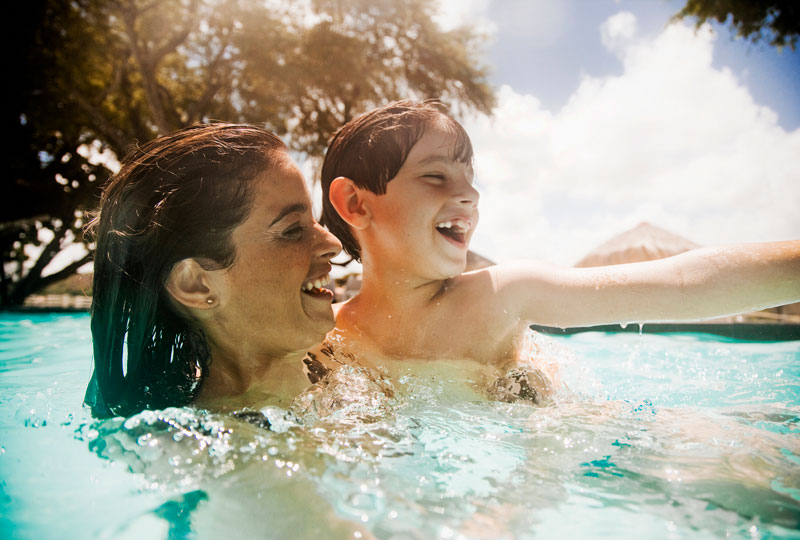It’s always important to keep drowning prevention and swimming pool guidelines in mind. As summer approaches, concerns over water safety amid COVID-19 must take precedence.
Traditionally Memorial Day marks the beginning of summer, the opening of area pools and boating activities.
As some prepare to enjoy these summer pastimes, experts at Monroe Carell Jr. Children’s Hospital at Vanderbilt urge adults to be mindful of CDC swimming pool guidelines.
This year, due to COVID-19, there are a few more tips to add to the list.
Always, the routine ABCs of water safety apply: Adult supervision, Barriers/boating safety and Classes. But this summer, experts stress that social distancing also remains a high priority when families are at the pool.
“If you are considering taking a dip in your area pool, there are few more things to consider,” said William Schaffner, M.D., professor of Preventive Medicine at Vanderbilt University Medical Center. “The biggest issue will be people and their proximity to each other. If you are going to a pool, wear a mask until you get into the water. Make sure the chairs around the pool are spaced to ensure appropriate social distancing. It will also be important to keep your distance while in the water. And always, always practice good hand hygiene.”
Schaffner recommends the following, based on CDC swimming pool guidelines:
- Homeowner associations should put up signs around pools, or within a newsletter, to alert people to new safety guidelines.
- Pools should set new capacity limits, to decrease the number of people at the pool at one time. This helps people stay at least 6 feet apart from each other.
- Avoid crowding other people.
- Keep a close eye on activity in the kiddie pool, to limit toddler interaction.
According to the Centers for Disease Control, there is no evidence that COVID-19 can be spread to people through the water in pools, hot tubs, spas or water play areas, especially with proper maintenance. Correct maintenance includes disinfection with chlorine and bromine.
As adults take heed of updated swimming pool guidelines and precautions, safety experts hope that will also reduce the number of drownings and near-drownings typically linked to summertime water activities.
Can social distancing lead to fewer drownings?
“Drowning is a silent killer,” said Purnima Unni, MPH, Pediatric Trauma Injury Prevention Program Manager at Children’s Hospital. “In less than two minutes under water, a child can lose consciousness, and brain damage can occur after just four to six minutes.
“This summer, the pool experience will be very different from what most people are accustomed to, but perhaps with the emphasis on social distancing, there will be fewer incidents. As adults keep a closer eye on swimmers, we will hopefully see a drop in these preventable injuries and avoid any distractions.”
Adults should be aware that drowning doesn’t look like the dramatic splashing or shouting that’s often depicted in movies or TV shows, Unni said. “The sad truth is that many times the child slips under water silently and even people near or in the pool with them have reported hearing nothing during drowning incidents.”
Drowning remains the leading cause of unintentional deaths for children ages 1 to 4; two children younger than 14 die from drowning each day in the U.S., and near-drowning incidents leave many with long-term consequences including memory problems, learning disabilities and other permanent physical limitations.
Safety experts say constant adult supervision is a must.
Learn about the ABCs of water safety:
A – Adult supervision
- Active adult supervision is arguably the most important water safety rule. At least one adult should be focused on the pool and close enough to touch the swimmers if necessary.
- Designate an adult “water watcher.” This person’s sole responsibility is to watch the pool area for 15 minutes and not read or talk on the phone. After 15 minutes, pass the responsibility to another adult for 15 minutes, and so forth. Ensure that the “water watcher” is a sober adult who knows CPR and has basic swimming skills.
- “Floaties” (inflatable armbands) or other inflatable flotation devices are not life jackets and should never be substituted for adult supervision.
B – Barriers and boating safety
- Have a properly working physical barrier such as a fence, pool safety cover and pool alarm (one meeting code requirements).
- If the home opens directly to the pool, door alarms and locks should be installed.
- Always swim at a lifeguarded beach and pay attention to the beach warning flags.
- On a boat, wear properly fitted U.S. Coast Guard-approved life jackets while on a boat.
C – Classes
- Teach children to swim. The American Academy of Pediatrics recommends swimming lessons for children as young as 1.
- Adults and children 13 and older should learn infant and child CPR.

